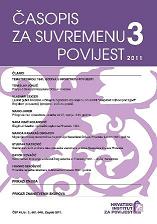Prilog raspravi o karakteru ustanka od 27. srpnja 1941. godine
A CONTRIBUTION TO THE DISCUSSION ABOUT THE CHARACTER OF THE UPRISING OF JULY 27, 1941
Author(s): Mario JarebSubject(s): History
Published by: Hrvatski institut za povijest
Keywords: Uprising; July 27; 1941; Guerilla Fighters; Insurgents; Communist Party; Partisans; Chetniks
Summary/Abstract: From 1945 to 1990 in the People’s/Socialist Republic of Croatia and in the People’s/Socialist Republic of Bosnia and Herzegovina July 27 has been celebrated as national holiday known as the Day of the Uprising of the Peoples of Croatia (the Day of the Uprising of the Peoples of Bosnia and Herzegovina). Communist regimes in both republics of Tito’s Yugoslavia claimed that on that day in 1941 masses led by the Communist party initiated the uprising against “Fascist occupation and domestic collaborators” (against the Ustasha regime of the Independent State of Croatia, Nezavisna Država Hrvatska, NDH). Allegedly led exclusively by the Communist Party, insurgents in Croatia initiated the struggle on that day in the tiny town of Srb by liberating it from the NDH authorities. Earlier that day insurgents have gathered around the town of Drvar in southwestern Bosnia and attacked it. Events in Srb and Drvar triggered the uprising and within few days insurgents put under their control large territories of Lika and Northern Dalmatia in Croatia and large territories in Sothwestern Bosnia. All of the territories were predominantly inhabited by Serbian population which was motivated to join rebellion against the NDH. Ustasha atrocities forced many Serbs to do anything to secure their lives and the lives of their families, so armed uprising looked like the only way to achieve that goal. Behavior of numerous insurgents also shows that many were determined to fight against any Croatian state and against Croats and Muslims as ethnic and religious groups. In the eyes of many insurgents all Croats and Muslims were collectively guilty for Ustasha crimes. Before 1990 official propaganda claimed that the Communist Party of Yugoslavia/Croatia had been the sole organizer and leader of the uprising. Indeed numerous insurgents’ leaders were communists. Communists desired to lead massive uprising all over Croatia, which could become possible only if wider layers of Croatian population would join in. However, the behavior of numerous insurgents was totally opposed to that element of Communist policy and Croatian and Muslim populations on territories under their control were exposed to the reign of terror and mass extermination. It is more than obvious that the Party could not control many of the insurgents. It is also clear that the composition of insurgents’ ranks was more complex than the propaganda would ever be ready to admit. It is also obvious how there were other influential groups and individuals among them. Many of those later became the Chetniks of Draza Mihailovich. However, in the summer of 1941 it was still not possible to consider insurgents in the above-mentioned regions either as partisans or Chetniks. They referred to themselves simply as insurgents (ustanici) or Guerilla fighters (gerilci). Their units and detachments appeared in public as Guerilla units. The Central Committee of the Communist Party of Yugoslavia adopted the name partisan for its fighters...
Journal: Časopis za suvremenu povijest
- Issue Year: 43/2011
- Issue No: 3
- Page Range: 751-771
- Page Count: 21
- Language: Croatian

